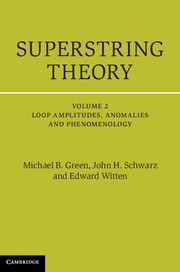Book contents
- Frontmatter
- Contents
- Preface to the 25th Anniversary Edition
- 8 One-loop diagrams in the bosonic string theory
- 9 One-loop diagrams in superstring theory
- 10 The gauge anomaly in type I superstring theory
- 11 Functional methods in the light-cone gauge
- 12 Some differential geometry
- 13 Low-energy effective action
- 14 Compactification of higher dimensions
- 15 Some algebraic geometry
- 16 Models of low-energy supersymmetry
- Bibliography
- References
- String Field Theory
- Index
Preface to the 25th Anniversary Edition
Published online by Cambridge University Press: 05 September 2012
- Frontmatter
- Contents
- Preface to the 25th Anniversary Edition
- 8 One-loop diagrams in the bosonic string theory
- 9 One-loop diagrams in superstring theory
- 10 The gauge anomaly in type I superstring theory
- 11 Functional methods in the light-cone gauge
- 12 Some differential geometry
- 13 Low-energy effective action
- 14 Compactification of higher dimensions
- 15 Some algebraic geometry
- 16 Models of low-energy supersymmetry
- Bibliography
- References
- String Field Theory
- Index
Summary
In the twenty-five years since the original publication of these two Volumes, there have been numerous developments in string theory. The curious twists and turns that marked its pre-1987 evolution have continued apace, and current research makes contact with a wide range of areas of mathematics and physics. In the following we will mention briefly some of these developments and then explain why we believe that these volumes are still useful.
Major insights into the non-perturbative structure of string theory followed from the discovery of non-perturbative duality symmetries of super-string theory. This led to the realization that the myriad of apparently distinct superstring theories that arise in ten or fewer dimensions actually are different perturbative approximations to the same underlying theory, which has come to be known as M-theory. Furthermore, M-theory has eleven-dimensional supergravity as another semiclassical limit. The understanding of these interconnections was aided by the simultaneous discovery of the properties of a family of dynamical objects called p-branes, which are extended objects that fill p spatial dimensions, as opposed to the 1 dimension of the string. p-branes can be viewed as solitons that are generalizations of the magnetic monopoles of conventional quantum field theory and the black holes of general relativity. Indeed, these discoveries have stimulated impressive advances in understanding the quantum and thermodynamic properties of large classes of black holes.
An important outcome of these considerations has been striking progress in understanding the nonperturbative structure of the quantum field theories that arise from string theory in various limits.
Information
- Type
- Chapter
- Information
- Superstring Theory25th Anniversary Edition, pp. xi - xiiPublisher: Cambridge University PressPrint publication year: 2012
